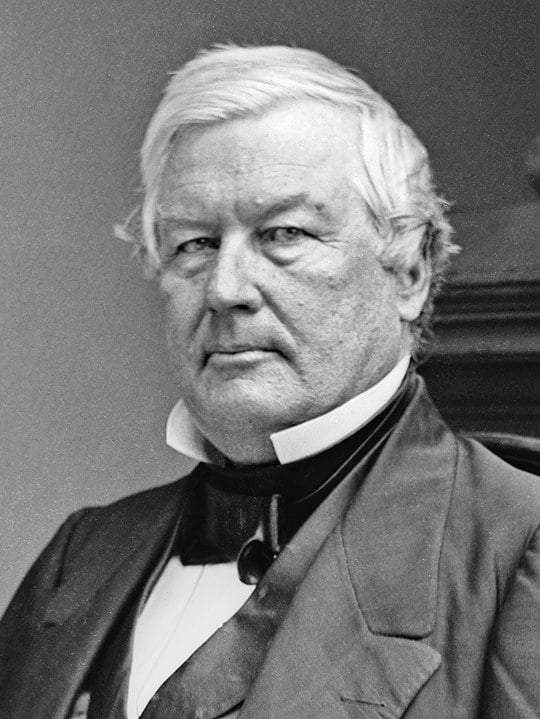Millard Fillmore (1800-1874) was the last member of the Whig Party to serve as a U.S. president, which he did from 1850 to 1853.
Born in New York, Fillmore, who had arisen from humble circumstances. He did not attend college, but had become a lawyer and became interested in politics. He served as a member of the U.S. House of Representatives, where he became chair of the powerful Ways and Means Committee; became the comptroller of New York; and (in an attempt to balance a Southern candidate with a Northern one) was chosen as vice president under Zachary Taylor.
Fillmore became president when Taylor died.
Fillmore’s political affiliation changed during his career. He entered politics as a member of the Anti-Mason Party, became a Whig, ran unsuccessfully for president as a member of the Know Nothing Party in 1856, and then became a Democrat.
Mormon church polygamy becomes issue during Fillmore's term
In 1850, Fillmore appointed Brigham Young as governor of the Utah Territory. Two years later, the Church of Jesus Christ of Latter-Day Saints announced that it approved of polygamy, a practice that would continue to stir anti-Mormon sentiment and opposition to Utah statehood in much of the nation until the church repudiated this position in 1890.
Fillmore supports Compromise of 1850 over slavery
Early in Fillmore’s presidency, he settled boundary disputes between Texas and the territory of New Mexico. In similar fashion, whereas Taylor had favored admitting New Mexico and California as free states, Fillmore, who had played only a minor role in Taylor’s administration, supported the Compromise of 1850, largely formulated by Sen. Henry Clay of Kentucky, as a way of preserving the Union.
The compromise admitted California as a free state while leaving the status of the New Mexican and Utah territories to be decided by popular sovereignty. The legislation also sought to strengthen fugitive slave laws while prohibiting the sale (albeit not the possession of slaves) in the District of Columbia.
Fillmore’s attempt to unite the nation by running for president in 1856 as a Know Nothing candidate was more problematic. The party was known chiefly for its anti-Catholicism and anti-immigrant stance and Abraham Lincoln seized upon this in a letter that he wrote on Aug. 24, 1855, in which he observed that “When the Know-Nothings get control, it [the Declaration of Independence] will read ‘all men are created equal, except negroes, and foreigners, and Catholics” (Vile 2017, 195).
Fillmore had himself repudiated the party’s anti-immigrant stance (Greenstein and Anderson 2013, 52).
As president, Fillmore opposed efforts by so-called American “filibusterers” to seize Cuba and central American nations as a way of extending slavery.
Letter to Japan emperor promises no interference with religion
In 1853, President Fillmore sent Commodore Matthew Perry to Tokyo Bay to open trade with Japan. Perry presented the government with a public letter from President Fillmore in which he assured the Japanese emperor that the U.S. interest was limited to trade and friendship. To this end, he observed that “The Constitution and laws of the United States forbid all interference with the religious or political concerns of other nations. I have particularly charged Commodore Perry to abstain from every act which could possibly disturb the tranquility of your imperial majesty’s dominions.”
In 1833, the U.S. Supreme Court had decided in Barron v. Baltimore (1833) that the provisions of the Bill of Rights, including the First Amendment, did not apply to the states, and it does not appear to have issued any significant decisions on the First Amendment during Fillmore’s presidency.
The court's most important decision during Fillmore’s presidency was in Cooley v. Board of Port Wardens of Philadelphia, 7 Pet. 243 (1833), in which it decided that the constitutional grant to Congress to control interstate commerce did not preclude state regulations of local matters, such as whether local pilots were needed in ports.
Fillmore’s efforts to preserve union did not avert war
As president, Fillmore appointed Daniel Webster as his secretary of state. Fillmore also appointed Benjamin Curtis of Massachusetts to the Supreme Court, where he served from 1851 to 1857. The Whig Party did not renominate Fillmore, and he was succeeded in office by Franklin Pierce, who was a Democrat.
Although the adoption of the Compromise of 1850 preserved the Union for a time, its provisions for popular sovereignty and for more vigorous enforcement of the fugitive slave laws led to continuing friction between Northern and Southern states and ultimately resulted in the dissolution of the Whig Party.
In 1851, Harriet Beecher Stowe published Uncle Tom’s Cabin, which drew further attention to the evils of slavery. Neither of Fillmore’s two presidential successors was able to resolve the conflicts over slavery.
When the conflict between the Union and the Confederacy finally came, Fillmore initially supported the Union cause, but he later opposed Lincoln and supported Andrew Johnson’s policies.
John Vile is a professor of political science and dean of the Honors College at Middle Tennessee State University. This article was published on Jan. 16, 2024.

